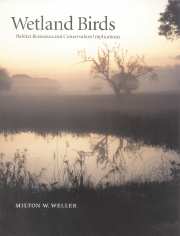Book contents
- Frontmatter
- Contents
- List of plates
- Preface
- Acknowledgments
- 1 Introduction
- 2 Wetlands: what, where, and why
- 3 Major groups of birds that use wetlands
- 4 Water and other resource influences
- 5 Foods, feeding tactics, strategies, and guilds
- 6 Bird mobility and wetland predictability
- 7 Other behavioral and physical influences on wetland living
- 8 Spatial and structural patterns
- 9 Habitat dynamics: water, plant succession, and time
- 10 Population consequences of wetland abundance and quality
- 11 How birds influence wetlands
- 12 Conservation implications
- 13 Measures of bird habitat use and quality
- 14 Current status and some conservation problems
- 15 Conservation and management strategies
- 16 Outlook
- 17 Epilogue
- Appendix 1 Scientific names of birds and bird groups
- Appendix 2 Scientific names of animals and animal groups other than birds
- Appendix 3 Scientific names of plants and plant groups
- Index of birds and bird groups
- Subject index
14 - Current status and some conservation problems
Published online by Cambridge University Press: 02 October 2009
- Frontmatter
- Contents
- List of plates
- Preface
- Acknowledgments
- 1 Introduction
- 2 Wetlands: what, where, and why
- 3 Major groups of birds that use wetlands
- 4 Water and other resource influences
- 5 Foods, feeding tactics, strategies, and guilds
- 6 Bird mobility and wetland predictability
- 7 Other behavioral and physical influences on wetland living
- 8 Spatial and structural patterns
- 9 Habitat dynamics: water, plant succession, and time
- 10 Population consequences of wetland abundance and quality
- 11 How birds influence wetlands
- 12 Conservation implications
- 13 Measures of bird habitat use and quality
- 14 Current status and some conservation problems
- 15 Conservation and management strategies
- 16 Outlook
- 17 Epilogue
- Appendix 1 Scientific names of birds and bird groups
- Appendix 2 Scientific names of animals and animal groups other than birds
- Appendix 3 Scientific names of plants and plant groups
- Index of birds and bird groups
- Subject index
Summary
Population declines of numerous migrant songbirds have rightfully aroused great public concern about the recent loss of tropical forest habitats. However, extensive coastlines and vast grasslands of North and South America, Africa, and Australia have been under human impact for hundreds of years. Migratory wetland birds of the northern hemisphere that skirted or flew over tropical forests also must have been greatly affected by coastal urbanization and development and by drainage of freshwater wetlands for agriculture, especially since the late 1800s. Such wetland losses undoubtedly influenced the decline of the northern water and grassland birds much as we now see in tropical forest regions. Scientists working with shorebirds and waterfowl have recognized and promoted multinational and global-scale conservation programs (Myers et al. 1987); such goals will continue to be one of our greatest conservation challenges.
Conservation of wetland birds resembles that of other groups of animal because all require a major emphasis on preservation of habitat, but it differs in its landscape or global scale. To this point, we have been discussing how habitat resources influence the success of wetland birds, and even how they compete for resources among themselves; we now examine how they compete with society for resources at several levels. Obvious, there is a tremendous geographic variation, and emphasis here will be mostly on the American scene because I know that best – not that it is necessarily better. In fact, most societies seem to have profited little from the past mistakes of other nations, even when communication is good.
- Type
- Chapter
- Information
- Wetland BirdsHabitat Resources and Conservation Implications, pp. 213 - 226Publisher: Cambridge University PressPrint publication year: 1999



